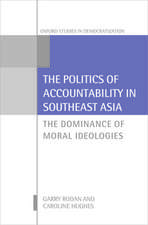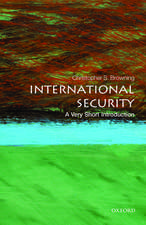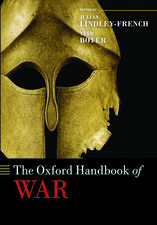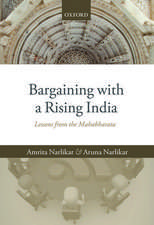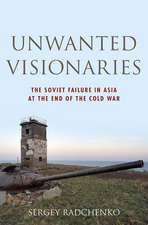Conflict and Security in Central Asia and the Caucasus
Autor Hooman Peimanien Limba Engleză Hardback – 7 iul 2009 – vârsta până la 17 ani
Preț: 373.86 lei
Preț vechi: 642.92 lei
-42% Nou
Puncte Express: 561
Preț estimativ în valută:
71.54€ • 74.88$ • 59.54£
71.54€ • 74.88$ • 59.54£
Carte tipărită la comandă
Livrare economică 31 martie-14 aprilie
Preluare comenzi: 021 569.72.76
Specificații
ISBN-13: 9781598840544
ISBN-10: 1598840541
Pagini: 400
Ilustrații: 30 bw illus
Dimensiuni: 178 x 254 x 30 mm
Greutate: 0.98 kg
Editura: Bloomsbury Publishing
Colecția ABC-CLIO
Locul publicării:New York, United States
ISBN-10: 1598840541
Pagini: 400
Ilustrații: 30 bw illus
Dimensiuni: 178 x 254 x 30 mm
Greutate: 0.98 kg
Editura: Bloomsbury Publishing
Colecția ABC-CLIO
Locul publicării:New York, United States
Caracteristici
Nearly 20 essays on vital topics such as the Islamic movement in Uzbekistan and NATO's Partnership for Peace program
Notă biografică
Hooman Peimani, PhD, is principal fellow at the Energy Studies Institute at the National University of Singapore.
Recenzii
Typical of the ABC-CLIO sources, this is an exceptionally well-done work. . . . This attractive volume is a valuable book worthy of consideration for a wide range of libraries.
Author Peimani builds on and updates previous publications with an analysis of conflict in Kazakhstan,Kyrgyzstan, Tajikistan, Turkmenistan, and Uzbekistan in central Asia, and Armenia, Azerbaijan, and Georgia in the Caucasus. .Readers will also find chronologies, well-documented tables, black-and-white photographs, six easy-to read themed maps (e.g., "Commonwealth of Independent States"), and 21 sidebars that review key issues (e.g., "Russian Bases in Kyrgyzstan and Tajikistan"). Peimani's text represents a frank and objective assessment. Also available as an e-book, this title will work equally well in a library's circulating collection.
This volume reviews the factors contributing to intra- and interstate conflict in Central Asia and the Caucasus. It contains regional essays discussing topics such as the transition from communism, elections in Azerbaijan and Georgia, and oil politics and economics in the Caucasus, followed by country profiles of Kazakhstan, Kyrgyzstan, Tajikistan, Turkmenistan, Uzbekistan, Armenia, Azerbaijan, and Georgia. It then presents essays discussing the Commonwealth of Independent States, the Economic Cooperation Organization, the Collective Security Treaty Organization, the Shanghai Cooperation Organization, the Organization for Democracy and Economic Development, and the North Atlantic Treaty Organization. Finally, the conclusion reviews major trends and assesses scenarios for possible armed conflicts in the future.
In this highly informative and timely book, the author provides the necessary background information and current data to better understand the sources of conflict and security in today's Central Asia and the Caucasus. . . . Highly recommended. All undergraduate, graduate, and research collections.
Author Peimani builds on and updates previous publications with an analysis of conflict in Kazakhstan,Kyrgyzstan, Tajikistan, Turkmenistan, and Uzbekistan in central Asia, and Armenia, Azerbaijan, and Georgia in the Caucasus. .Readers will also find chronologies, well-documented tables, black-and-white photographs, six easy-to read themed maps (e.g., "Commonwealth of Independent States"), and 21 sidebars that review key issues (e.g., "Russian Bases in Kyrgyzstan and Tajikistan"). Peimani's text represents a frank and objective assessment. Also available as an e-book, this title will work equally well in a library's circulating collection.
This volume reviews the factors contributing to intra- and interstate conflict in Central Asia and the Caucasus. It contains regional essays discussing topics such as the transition from communism, elections in Azerbaijan and Georgia, and oil politics and economics in the Caucasus, followed by country profiles of Kazakhstan, Kyrgyzstan, Tajikistan, Turkmenistan, Uzbekistan, Armenia, Azerbaijan, and Georgia. It then presents essays discussing the Commonwealth of Independent States, the Economic Cooperation Organization, the Collective Security Treaty Organization, the Shanghai Cooperation Organization, the Organization for Democracy and Economic Development, and the North Atlantic Treaty Organization. Finally, the conclusion reviews major trends and assesses scenarios for possible armed conflicts in the future.
In this highly informative and timely book, the author provides the necessary background information and current data to better understand the sources of conflict and security in today's Central Asia and the Caucasus. . . . Highly recommended. All undergraduate, graduate, and research collections.

